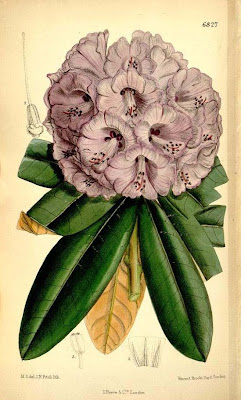
Curtis's Botanical Magazine, Vol., LXXIX table 4730 (1853)
Rhododendron niveum. Hook.fil. Rhod. Sik. Himal. Conspect. p. 4.
Found by Dr. Hooker in Sikkim Himalaya ; rocky valleys and ridges, Lachen, Lachong, and Chola; elevation 10,000 to 12,000 feet, not unfrequent: but he was not so fortunate as to meet with flowering specimens of this plant during his sojourn in Sikkim Himalaya. Yet from the fruiting ones he determined the species to be new, and he determined rightly. One of our young plants in the Royal Gardens produced the flowers here represented in May, 1853, and they afford additional characters to those derived from the peculiar form of the fruit, and the snow-white, flocculent, opaque tomentum occupying both surfaces of the very young leaf —permanent beneath—as distinguishing it from R. arboreum and from R. Campbellite. The colour of the flowers is indeed very different from either, and not unlike that of the European R. ponticum and the North American R. maximum, but showing deep sanguineous spots at the inner base of the corolla, where, alternating with them, are five membranaceous decurrent scales or plicae. The calyx is obsolete, reduced to a small oblique scarcely lobed disc, and there is a very large hypogynous annular lobed ring, in which the ovary is inserted.
Descr. A small shrub, with rugged bark on the older stems and branches. Leaves moderately large, spreading, opaque on both sides, obovato-lanceolate, tapering below into a short footstalk, the young leaves white-tomentose all over; the younger ones glabrous above, clothed beneath with white (rarely tawny) appressed flocculent tomentum. Flowers rather numerous, moderately large, on short tomentose peduncles. Calyx very small and inconspicuous, indeed concealed by the narrow base of the corolla, oblique, obsoletely five-toothed. Corolla externally yellowish-lilac, internally palish lilac, blotched with deeper lilac, and at the inner base having five, deep, blood-purple spots; the form is broadly campanulate, narrow at the base of the tube but there five-lobed; the limb spreading, five-lobed, retuse and slightly lobed and waved. Stamens ten, shorter than the corolla: Filaments glabrous. Ovary oval, very tomentose, seated on a large fleshy lobed annular disc, generally six-celled. Style declined, curved upwards towards the apex. Stigma a mere obtuse point. Capsule oblong or oval-oblong, terete, olive-brown, downy.
Fig. 1. Portion of the base of the corolla, seen from within. 2. Stamen. 3. Ovary. 4. Ditto, cut through transversely:—magnified. 5. Capsule:—not. size

Var. Fulvum
Curtis's Botanical Magazine Vol., CXI, t. 6827 (1885)
The var. fulva is one of the original plants raised from seeds sent by me in 1848-9 from Sikkim, and is planted in a border bed in the S.W. angle of the Temperate House, where it flowered freely annually, and far exceeds in beauty the type of the species [differs with tawny indumentum instead of silver and darker coloured flowers similar to R. ponticum] which is no longer in cultivation in that house.
It is a singular fact, that though the province of Sikkim has been thrown open to collectors and travellers for upwards of thirty years since the first Rhododendron seeds were sent home from its mountains, there has been no addition to the number of species found there in 1849. These amounted to thirty (or forty, including strongly marked varieties published as species), of which more than half were new to science, and only three were known in cultivation. On the other hand, later collectors have added not a few varieties to the known kinds, some of which are exceedingly puzzling, notably the form of R. Falconeri and R. cinnabarum. The journeys of Mr. Booth, collecting for the late Mr. Nuttall in the neighbouring country of Bhotan, resulted in an addition of eight new kinds, and of a number of varieties or forms of the previously discovered Sikkim ones. Altogether twenty-seven species are known from Bhotan, of which eighteen are natives of Sikkim, and one of countries south of Bhotan. Putting these data along with the fact that the Bhotan Alps have never been explored to the height at which Rhododendrons are found in Sikkim, it follows that a rich harvest of the genus remains to be garnered in the former country.
J.D.H.

No comments:
Post a Comment